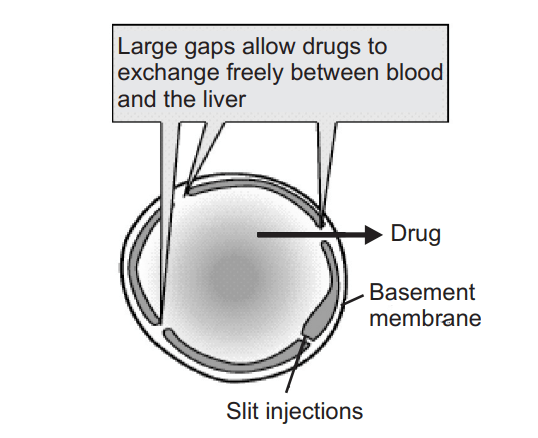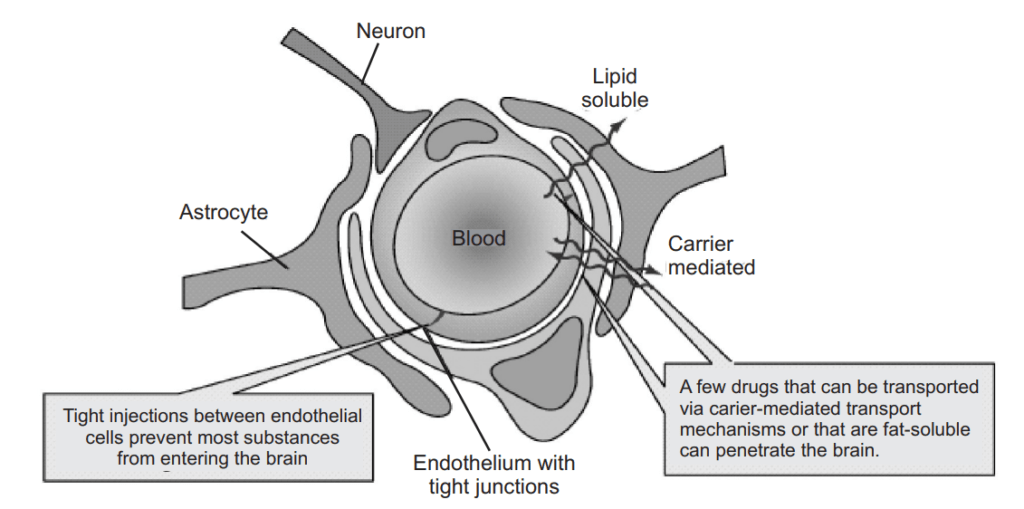Distribution of Drugs
Once a drug is absorbed in the systemic circulation, it can be carried throughout the body. This process is called as distribution. It is a reversible process. Some molecules may be interacting with receptors on cell membranes or inside of cells, while other molecules may move back into the bloodstream. The delivery of a drug from the bloodstream to the site of drug action depends on blood flow, capillary permeability, degree of binding to blood and tissue proteins, and relative lipid-solubility of the drug molecule.
Blood flow to the different organs of the body is unequal. The most vital organs like the brain, liver, and kidneys receive the greatest supply of blood. Skeletal muscles and bone receive relatively less blood supply and adipose tissue/fat receives minimum blood supply. Penetration into the central nervous system is yet another factor. The anatomical structure of capillary networking in the brain creates a barrier to the passage of many drugs in the CNS. This is called as the blood-brain barrier. Lipid-soluble substances enter the brain very easily. This explains why fat-soluble anesthetic gases easily penetrate the brain to cause anesthesia while water-soluble penicillin antibiotics penetrate the CNS to a lesser degree.
If impermeable capillaries of the brain are compared with highly permeable capillary walls in the liver and spleen (Fig. 1.1), the anatomical difference and distribution characteristics can be clearly seen. Capillaries of the liver have gaps between their cells which allow large proteins to pass through the capillary basement membrane. In order to function, the liver must have access to amino acids, sugars, and other large molecules from the bloodstream. These molecules undergo chemical processing in the liver, and then must be moved out of hepatic cells and back to the bloodstream. Unlike the liver, capillaries of the brain have endothelium with tight junctions. This prevents the entry of water-soluble substances into the brain. Only a few drugs that can be transported by carrier-mediated mechanisms or are fat soluble can penetrate the brain. Thus, the permeability of the capillaries decides the distribution of the drug to the organ.


Figure 1.1: Structure of capillaries
Factors Affecting Distribution of Drugs
Most drugs reversibly bind to plasma proteins to a varying degree. Albumin is the most abundant plasma protein with the ability to bind drugs. Only a free fraction of the drug is biologically active. There is an equilibrium between free and bound drugs to proteins like albumin. Albumin acts as a reservoir for the administered drug. Some drugs may have a binding of 95-98% to albumin. With highly protein-bound drugs, low albumin levels (as in the case of protein-calorie malnutrition or chronic illness) may lead to toxicity because of lesser binding sites. Hence, identifying the patient’s serum albumin level can help in deciding the dose of a highly protein-bound drug.
Competition for binding sites is yet another factor. If two drugs can compete for the same site on albumin and one drug is capable of displacing another drug from the site of binding, then an interesting drug interaction is observed. A known example of this is phenylbutazone displacing warfarin from protein binding sites. In this case, a patient receiving warfarin earlier will get the effects of anticoagulation by administration of phenylbutazone. The cause is the displacement of warfarin due to phenylbutazone.
Other patient variables that can affect distribution include body composition, cardiac decompensation (heart failure), and age of the patient. These factors affect the volume of distribution (Vd) of a drug. Vd is the hypothetical volume needed to account for all of the drugs in the body based on serum concentration in a blood sample. Higher Vd indicates lower serum concentration and greater distribution of the drug in the body. Lower Vd indicates higher serum concentration and limited distribution of the drug in the body.
Dosing of medications in infants and children requires special consideration. It is to be noted that “children are not simply small adults”. The bodies of children/infants contain a high percentage of water and a low percentage of muscle and fat. Especially in neonates, albumin may be lower. All these variations can alter Vd significantly; hence dosage for neonates/infants/children should be carefully adjusted.
Make sure you also check our other amazing Article on: Factors Affecting Drug Absorption
